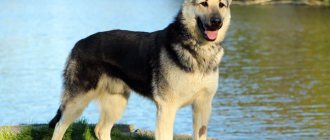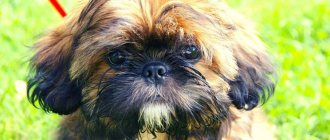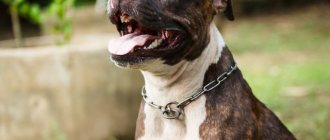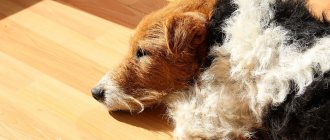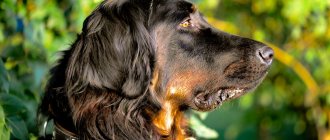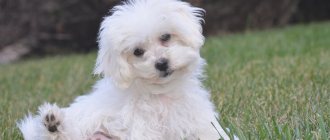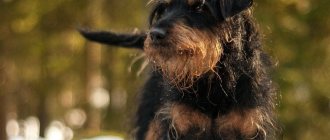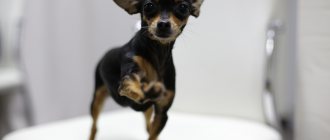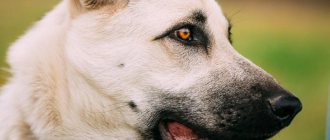Training an East European Shepherd at home is a troublesome task, but always interesting and rewarding. You have chosen your friend - an East European Shepherd puppy, and you have made the right choice!
Let's meet! Eastern!
Now your task is to raise your dog to truly become a reliable friend, companion and helper. This requires training.
East European Shepherd (VEO) - a brief description of the breed
The East European Shepherd is a universal favorite today. This animal stands out from others with its lively mind and amazing intelligence. The dog is considered very hardy and amenable to training; it is extremely unpretentious.
This breed was originally bred as a service animal. Its main purpose was to work in the military forces. Often she was entrusted with the protection of territories and important objects. But the popularity of this dog grew so quickly that soon representatives of this breed could be found everywhere: they guarded private houses, accompanied their owners on walks, acted as guides for the disabled, and even starred in films and TV series.
Comparison with the German Shepherd
Many people ask the question: what is the difference between the East European Shepherd and the German and is there any difference at all?
There are still differences between them. To begin with, the VEO has a much larger build and is taller than the German Shepherd. These dogs are physically healthier and have greater resistance to harsh climates. The movements of the “easterners” are more sweeping. The character of the East European Shepherd is calm, while the Germans are very playful and active. Eastern Shepherds are still more suitable for service. The main purpose of the German Shepherd in our time is the role of a companion dog.
How to train and educate VEO
Training an East European Shepherd at home is a troublesome task, but always interesting and rewarding. You have chosen your friend - an East European Shepherd puppy, and you have made the right choice!
Now your task is to raise your dog to truly become a reliable friend, companion and helper. This requires training.
History of appearance
The East European Shepherd is considered a relatively young breed. The first “Germans” came to Russia already in 1904. But the purposeful breeding of “Easterns” began in the late 30s of the 20th century.
The Soviet Union was very successful in this, since it needed the animal specifically for work. A prerequisite was considered to be that the dogs had endurance and great physical strength. The authorities set a task for dog handlers: to breed a universal animal that could easily serve throughout the territory of the Union.
East European Shepherds were sent to the Great Patriotic War, where they showed only positive qualities and great performance. These dogs saved the wounded and blew up tanks.
The German Shepherd has had positive ratings in many countries. But after the war, everything that was in any way associated with Germany received a negative review. Targeted work has begun to modify this breed. Long-term work of breeders and competent mixing with other breeds helped achieve positive success. The East European Shepherd appeared in the form in which we know and see it now.
There was a moment in history when this breed was in danger of extinction. But thanks to the painstaking work of specialists, it was nevertheless revived.
After the Second World War, the breed was awarded the title of patriotic breed.
Nowadays, “Europeans” are gaining more and more popularity.
Dog appearance (standards)
The breed standard was formed by the 70s of the last century.
Dimensions
Males and females of this dog breed differ in size. Males are never small, they are approximately 65-76 cm tall. Females are slightly shorter: on average their height is 62-72 cm.
The animal's weight fluctuates significantly. If the animal's diet is well balanced, the East European Shepherd can reach a weight of 60 kg. Smaller individuals can weigh about 30 kg. The height of the animal, its gender and individual development have a direct impact on the amount of weight.
Wool
The shepherd's coat is usually medium to short in length. The exception is the outer sides of the forearms and thighs, where the hair is longer. On the ears, head and paws it is, on the contrary, shorter. There is a small undercoat.
The animal's fur is hard, even coarse, and lies tightly to the body. Thanks to this, the Eastern Shepherd Dog tolerates both heat and cold very well; weather changes do not cause it any discomfort.
Long hair is considered a defect.
Colors
Among the “easterners” the black-backed color usually predominates. There are animals with black coat color.
Colors such as gray and red are allowed by the standard, but are not desirable.
Head
The “Eastern” dog has a proportional head, shaped like a not very pointed wedge. Nose is black. The ears can be compared to an isosceles triangle.
Ears should always be erect.
Hanging ears indicate that the animal has poorly developed muscles.
Teeth and jaws
The East European Shepherd has a scissor bite and a powerful lower jaw. The animal has 42 teeth.
Eyes
An animal's eyes can be either dark or light. More often, however, there are dogs with brown or even black eyes.
Body and limbs
The East European Shepherd is naturally blessed with strong bones. The body of the animal has a slightly elongated shape, the chest is oval. The dog's back is straight and wide, its belly is always tucked up. The shepherd has well-developed muscles.
The front legs are straight. The hindquarters are wide, the thighs are strong and muscular. The toes on the front and hind limbs seem to be gathered into a ball. Paws are oval shaped.
Tail
"Vostochnik" has a straight tail. At rest it is usually lowered. A sign of a dog's good mood can be a tail arched.
Rock defects
Any deviation from the generally accepted standard is considered a defect.
Character of the East European Shepherd
The character of this shepherd showed exactly those qualities that are necessary for a real security guard. This animal is very distrustful and attentive to strangers. On the other hand, the dog is quite balanced and knows its own worth. She has good nerves, so she is not characterized by causeless aggression. But if the situation gets out of control and could pose a threat to life or health, the dog will react with lightning speed and take a defensive position.
The “European” is focused on its owner. He is ready to show all his best qualities by carrying out a person’s order. The dog is so devoted to his owner that he will protect him in any conditions.
The East European Shepherd always shows love to its family members. However, she never tries to take a dominant position. If other pets live next to the dog, these shepherds will not only not offend them, but will subsequently become their guardians, protecting them if necessary.
A dog can only relax and have fun in the company of its owner or with dogs of its own breed.
"Easterns" in general have a very good character.
Attitude towards the owner
The Eastern Shepherd gets used to its owner with amazing speed.
She is ready to serve him in any matter and fulfill his every desire. The animal does not tolerate separation well, even if the owner leaves for a few days out of necessity, the dog will be very bored. This is exactly the animal that will wait for its owner from work with sincere impatience, and after waiting, it will become his shadow, moving around the house and joyfully wagging its tail.
Attitude towards children
This breed, despite its formidability, treats children very well. From the first days, the dog loves its owner very much and, accordingly, simply dotes on his children. Naturally, the animal must first be raised correctly.
Attitude towards strangers
It is known that this dog is an excellent guard, showing wariness and attention towards strangers. Naturally, if you do not pay due attention to raising an animal, it will be aggressive towards strangers.
In suspicious situations, the dog will not think and weigh for a long time; it will immediately begin to attack. In order to avoid such unpleasant situations in the future, you need to raise a puppy from a young age.
Why is training needed?
Good manners and correct reactions of the East European Shepherd are the result of upbringing and training, that is, the influence on the dog’s behavior.
Only abilities and working qualities are inherited, which the owner can activate and strengthen with the help of an instructor-trainer or independently.
Raising a puppy is the same as teaching and raising a child at school and at home! Unresponsive to commands, unwilling to obey, or simply not knowing how to behave correctly in a given situation, VEO is a socially dangerous dog, a source of constant headache for the owner, just like any other dog, regardless of breed and size.
VEO must be raised in such a way that communication with her brings joy! And the basis of this long process should be love and sincere affection for the eared baby, who will subsequently turn out to be a large, strong, beautiful and very well-mannered, properly trained dog - the favorite of the whole family and the rightful pride of the owner.
Stages of initial training
Where to start training?
Conventionally, initial training (from 1 month to 1 year) can be divided into several stages corresponding to this age:
- socialization;
- obedience training;
- execution of basic commands.
All three stages are closely intertwined, and if you deprive your baby of the opportunity to go through one of the three stages, you will not be able to achieve further development and training of your shepherd.
After a year, other types and methods of training are used.
Care and maintenance
You immediately need to decide where the animal will live. The dog will be able to feel quite comfortable both in the apartment and on the street. The problem will only arise if you immediately place the animal in the house and then move it out into the yard. The pet will not understand what happened, it will miss its owner greatly and bother him with a long, sad howl.
If you have a private house, feel free to build an enclosure with a booth, there the “easterner” will feel more at ease.
If the animal has to live in an apartment, immediately give it its own place with a bed.
The VEO breed will not cause any difficulties in caring for. It is recommended to bathe the animal a couple of times a year, not more often. In the summer, it is advised to take the dog to a pond; if desired, it can swim and warm up.
You need to scratch your dog as needed. The exception will be the period of seasonal molting, then the animal will have to be scratched more often.
Brushing is also a beneficial massage that helps improve blood circulation.
If the animal is healthy, it is enough to examine its ears once every two weeks to remove natural wax secretions. The eyes are washed only if discharge appears.
The animal's teeth need to be brushed using a special brush and toothpaste. It may be helpful to give your pet solid treats. By chewing them, the dog will remove soft plaque from the teeth, leading to the formation of stone.
If you find tartar, you should definitely contact your veterinarian.
Periodically you need to inspect the fur of your four-legged friend for the presence of parasites such as fleas and lice. If they are found, you need to treat the dog with an antiparasitic agent and put a protective collar on it.
Be sure to vaccinate the animal and deworm it.
Vaccination begins at the age of 2-2.5 months. Animals are allowed to drive worms from the age of three weeks, not earlier. It is believed that if the pet's mother is not dewormed regularly, the baby becomes infected with these parasites through mother's milk.
Before each vaccination, it is necessary to carry out worming.
This procedure is recommended to be carried out at least 10 days before the intended vaccination.
How to feed an animal is also a question that deserves attention. You can give preference to premium or super-premium dry food. Or feed your pet natural food. In this case, you need to take into account the fact that the main component of the diet of an Eastern European dog is protein, so you need to provide the animal with a sufficient amount of meat. You can diversify your pet's diet with vegetables, sea fish, cereals, herbs, and dairy products.
There should be drinking water within the dog's reach.
East European Shepherds were participants in the Chechen War.
Training the East European Shepherd from childhood
Author Anton Staroverov Reading time: 5 min.
.4k. Published 10/03/2016 Updated 09/12/2019 Hello. Please tell me what to do with the VEO puppy. The dog is 2.5 months old. Difficulty with the toilet. We take him outside and the dog plays. We return from a walk to the apartment - he immediately runs to relieve himself. We tried to walk longer, to no avail. While there are no vaccinations, we take him out on a leash near the house. How to teach to go to the toilet outside. We live in an area where we can’t find dog handlers or trainers. How to raise an obedient dog.
Education and training
Walking with an East European Shepherd is a must. Walks should be long, it is advisable to supplement them with physical activity. The dog should not walk on its own. She needs a lot of attention every day to improve her mental and physical development.
You need to start raising a puppy from a very young age. Teach him obedience during walks. It is on the street that there are many distractions that attract the attention of a small puppy. Against the background of extraneous noise, the animal should listen and perceive only the owner.
A grown-up pet needs to be taught to jump over barriers and look for previously hidden things. If you want to develop service qualities in your dog, then you will have to conduct classes with the involvement of strangers. The animal's task in this case will be to pursue the intruder or guard your belongings. Usually, all the required knowledge is inherent in the shepherd at the genetic level, and training does not present any particular difficulties. VEO does not need to repeat commands for a long time and repeatedly; she grasps everything on the fly.
At one of the Moscow metro stations there is a sculpture of a border guard with an East European shepherd dog. There is an opinion among people that by simply rubbing a dog’s nose or touching its paw, you can become happy at least for a moment.
Age from 4 to 6 months
We continue to improve the already familiar commands, add a bicycle to the walk, and acquire the skills of fetching and jumping over low obstacles.
Since the puppy is still too small to push off strongly with his hind legs, and his ligamentous apparatus is still developing, the obstacle should not be higher than his shoulder.
VEO knows well that it is easier to get around an obstacle, so you will have to set an example of overcoming obstacles by taking the stubborn dog short on a leash and jumping over the obstacle together with your pet, encouraging both with a joyful exclamation: “Barrier!” After completing the jump, reward the dog with a treat and calm yourself down with equally joyful praise: “Ay, smart girl! Well done!!!"
We practice the command: “Near!”, master turns, slow down and speed up the pace at the request of the owner. We learn to bark on command: “Voice!” We teach a difficult command for dogs: “Lie down!” and the next one - “Crawl!” We practice the command: “Come to me!” to automaticity.
If you don’t teach VEO to perform the approach by the end of the 6th month, you can say goodbye to your leading position in the pack. In a couple of months, the grown puppy will try to challenge your place in the hierarchy.
We exercise daily, bringing the training to 30-40 minutes. in a day.
The end of training does not mean that the development of good manners ends with the dinner bell! On the way home, we give commands from time to time, making sure that the dog follows them. Before starting to learn a new command, ensure that the dog carries out the previous ones flawlessly.
Training ends on time, training never!
How to choose a puppy
If you are ready to buy an East European Shepherd, contact the kennel only! Only there is a strict record of animals and their droppings kept. In this case, you can be sure that you are getting exactly what you wanted.
The puppy must be absolutely healthy and have a puppy certificate or passport.
Ask the breeder any questions you are interested in, find out the pedigree of the puppy and its parents. Ask if they have participated in exhibitions and if they have received awards. Clarify questions about vaccination and feeding.
Now many nurseries have their own websites. On these sites you can choose your future four-legged friend and reserve him for future purchase.
When buying a puppy from an advertisement, you have every chance of acquiring, at best, a German shepherd, and at worst, a half-breed.
When do the eyes open and how much do they weigh?
Immediately after birth, such dogs do not hear or see anything. Among their sense organs, only their sense of smell is well developed. It is with his help that they find their mother in the first days of life. Within two weeks, the puppies' eyes open and they begin to see the world around them.
After birth, all Shepherd puppies are very similar to each other.
They have a black, pointed muzzle with a large nose and short fur. On average, newborn dogs weigh 300-500 g. Additional information. The more dogs in the litter, the less the VEO puppies weigh.
How much does a dog cost?
In Russia, an Eastern Shepherd puppy that has documents and a pedigree will cost from 15,000 rubles.
If you suddenly come across an advertisement where they ask for only a few thousand rubles, or even less, for a puppy of this breed, refrain from such a purchase. At best, the puppy’s parents do not have a pedigree, and at worst, the animal is sick or has a predisposition to diseases.
If you have fundamentally decided on an East European Shepherd, don’t look for price, but look for quality. It’s better to spend a little more money and get what you want than to save money and later be disappointed in the purchase.
Pros and cons of the breed
The advantages of the breed include the following:
- people-oriented;
- obedience and quick execution of the owner’s commands;
- great endurance;
- courage;
- strong nervous system;
- love for children;
- devotion.
But the breed also has disadvantages:
- a large animal requires more space to keep;
- the need for daily long walking;
- mandatory physical activity;
- excessive distrust of strangers;
- manifested aggression towards strangers in the absence of upbringing.
Age six months
Your young East European Shepherd is strong enough and mature enough to continue training in the basic OKD course and master the remaining lessons.
To the command: “Barrier!” we add the command: “Forward!”, and the dog easily flies over the barrier, picket fence or ditch, playfully passes the boom and runs down the stairs. Executes the command: “Stop!” without support from below. Finds and brings the item being imported. He approaches and takes the correct position on the command: “Come to me!”
We add execution of commands at a distance and by gestures. If the dog is accustomed to obeying and trusting its owner, and carefully monitors its facial expression and tone of voice, then it will not be difficult to correctly “educate” conditioned reflexes at a distance.
It will be difficult to get used to the muzzle and the shots. Difficult, but necessary!
